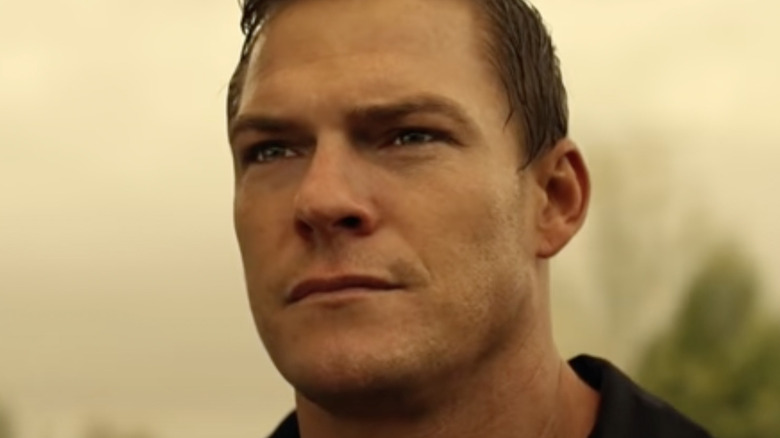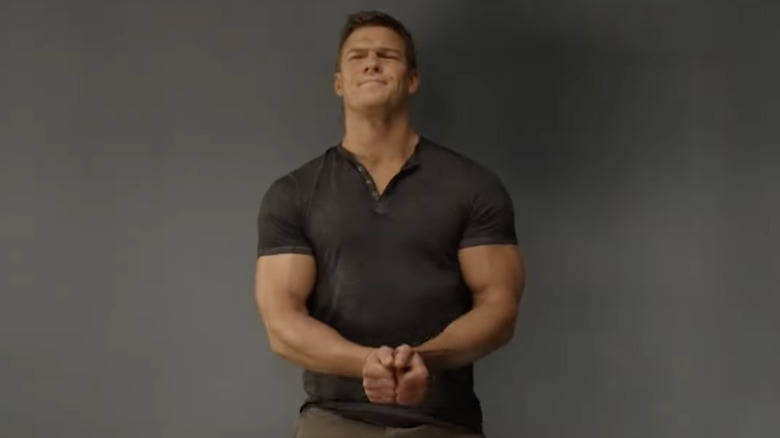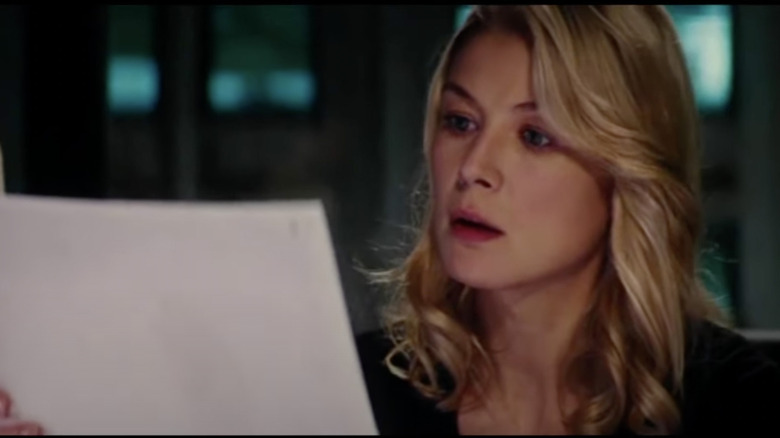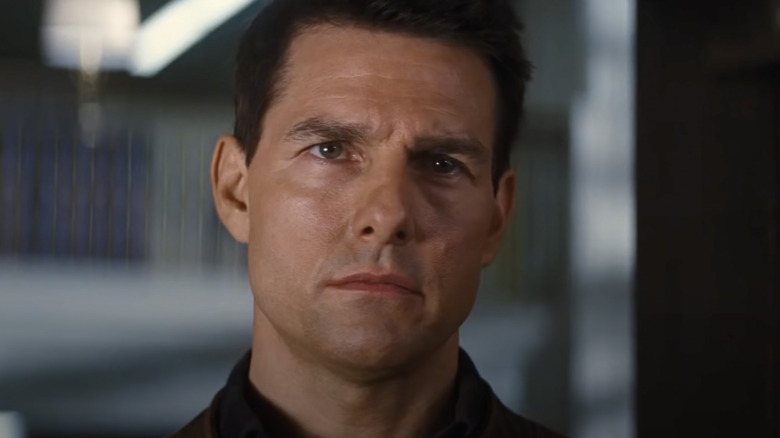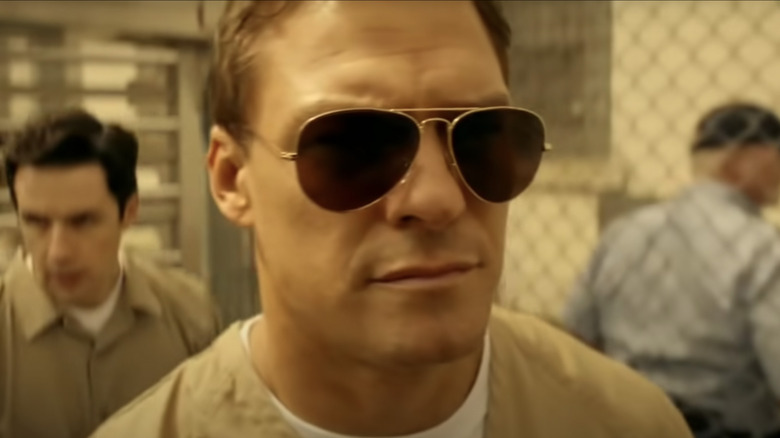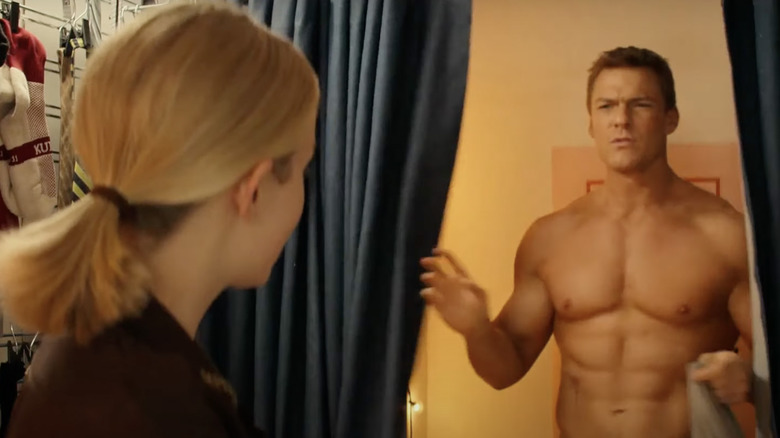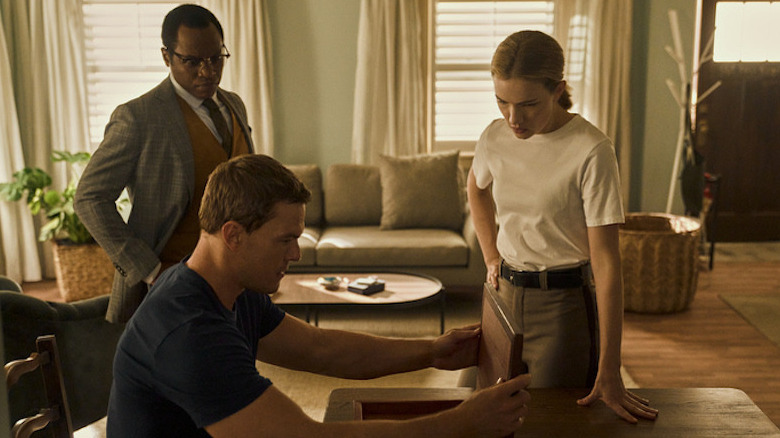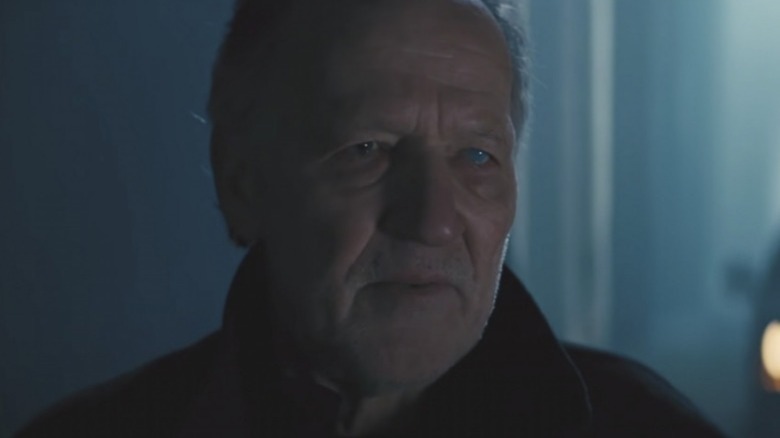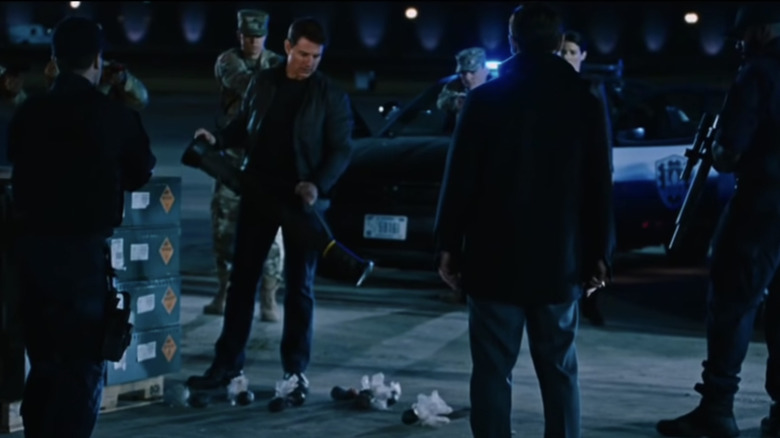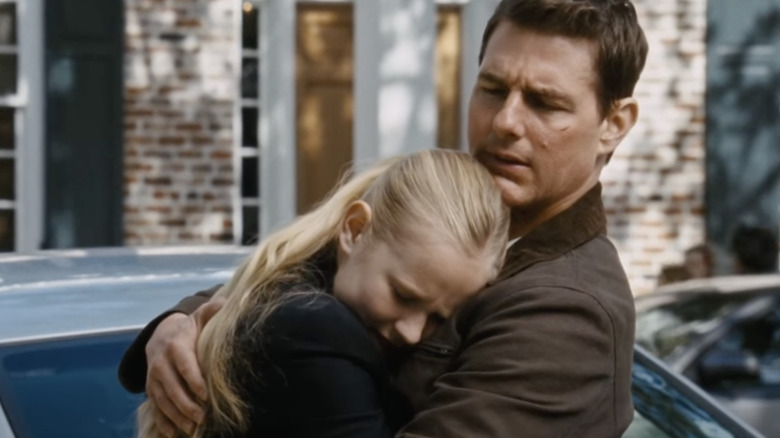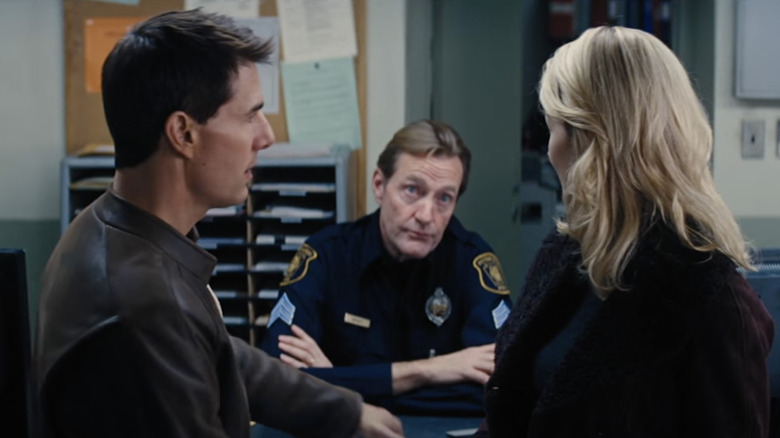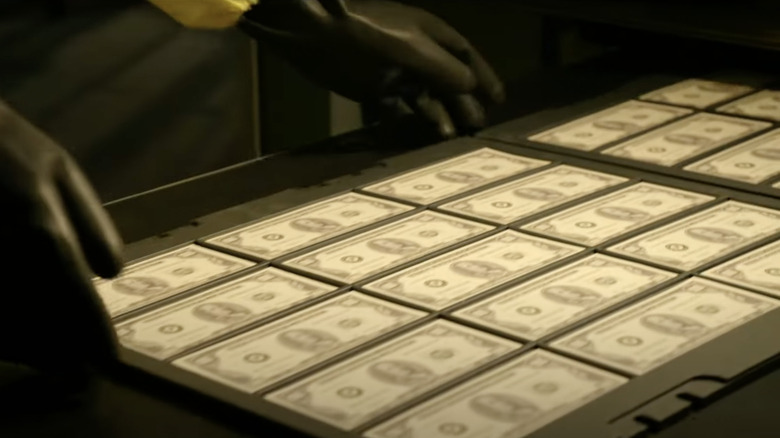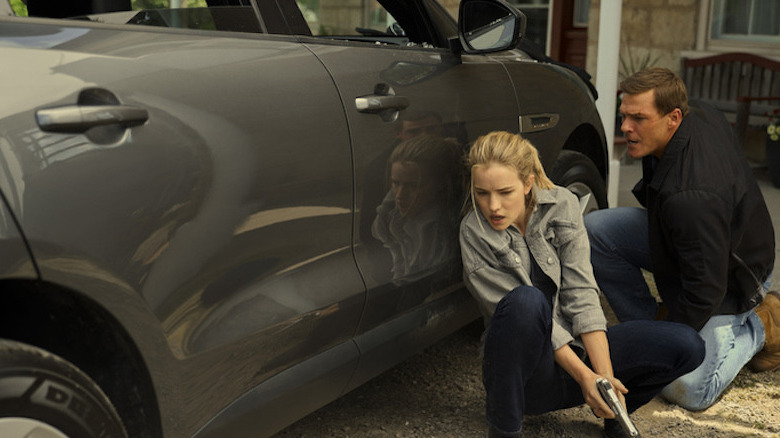The Biggest Differences In Reacher's Movies Versus The TV Show
Imagine if Sherlock Holmes were a WWE wrestler. Actually scratch that — imagine Batman took off his cape and cowl, changed his name, and started killing bad guys with little remorse. Imagine both those things at the same time, mash them together, and you'll have a halfway decent approximation of the gruff wanderer Jack Reacher.
Prior to 2012, the only people who got to enjoy Reacher's travels were fans of author Lee Child's sprawling literary universe, which revolves around the character. Thankfully, someone realized Reacher's high-octane adventures could be just as explosive onscreen as they were on the page, and the eponymous action-thriller movie "Jack Reacher" was born. Since then, the series has spawned a sequel — with both movies starring Tom Cruise — and a TV show, which features Alan Ritchson as the titular hero.
Whenever one actor passes the mantle of a big-name character onto another, fans can't help but compare the two, and in this case, there are plenty of differences. For starters, just look at the two men portraying Reacher. Like, c'mon. What did author Lee Child have to say about their differing statures? What about Ritchson himself — did he think he was bigger and better than Cruise?
All good questions, but we won't only cover backstage gossip about looks. We'll also watch some action scenes. So stick around free spirits and Reacher fans, and of course, be ready for spoilers ahead.
How high could each Reacher reach?
The first thing you need to know about Jack Reacher is that he's big. Well, at least one of them is. In the books, Reacher clocks in at six-foot-five and 250 pounds (per The New York Times). In real life, Alan Ritchson — at six-foot-two — sizes up much closer to the fictional Reacher. Cruise, on the other hand, measures five-foot-seven, and consequently he had to resort to different methods than sole physicality to embody Reacher's imposing energy.
In fact, the height discrepancy between Cruise and the fictional Reacher was a big issue for some fans when the first "Jack Reacher" appeared in cinemas, according to a piece from the LA Times. Cruise's casting caused such a stir that even author Lee Child was asked to comment on the decision (per Deadline). "Reacher's size in the books is a metaphor for an unstoppable force," Child said, "which Cruise portrays in his own way."
Bulk isn't everything, but it certainly helps. While Cruise did an excellent job portraying the intimidating Jack Reacher — with stony gazes and a hard upper lip — it's impossible to deny the paralyzing effect Ritchson's Reacher has. Just watch him get up and break out of a pair of zip-ties in the show's pilot. That is not a guy you want to mess with.
They used different source material
Another thing you should know is that the two movies and show are all entirely different stories. Not only that, but there's almost no connection between any of the three productions — no repeated characters, no home base, nothing. Pretty much the only link between them is Reacher himself. But they're all Jack Reacher properties, so where's the continuity?
The Jack Reacher saga spans 26 novels and counting, and in each novel, the wandering Reacher finds himself in some new place facing some new catastrophe (via Dead Good Books). As a result, the teams behind the movies and show had an abundance of novels from which to adapt their stories.
The newest one, Prime Video's "Reacher" series, is actually based on the very first published Jack Reacher novel, "Killing Floor," and as we'll see later, the original story had to be buffed up to fill eight episodes of TV. Next in order of publication is the first cinematically: "Jack Reacher," the movie, is based on the novel "One Shot," which was the ninth book published in the series. Finally the sequel movie, "Never Go Back," is the adaptation farthest along in the series timeline — it was the 18th book published. That means there's still 23 books for the Prime show to draw from.
Which adaptation is the most faithful to its source?
There's no easy calculation to determine which production is the most faithful adaptation. Though it's a tough call, some eager Reacher fans have tallied the differences between screen and page. According to Teen Entertainment Guide, there are only eight notable differences between the first "Jack Reacher" film and the source novel, "One Shot." These discrepancies are mostly small plot points, so on the whole, it's safe to call it a faithful adaptation.
"Never Go Back" is the production that seems to have taken the biggest leap, if The New York Times' review of the book is any indication. First off, the opening scenes are different. More crucially, there's a cross-country road trip in the novel that is completely absent in the movie. Reacher's alleged daughter is around far less, and the book doesn't have the stint in New Orleans featured in the movie.
With eight episodes, it was a lot easier for the showrunners to fit in even the small details of their source book, "Killing Floor." (And like Reacher says throughout the show, "Details matter.") However, a Rolling Stone review of the show wasn't convinced. While it said that the show was "a fairly faithful adaptation" of the book, Ritchson didn't manage to sell Reacher as a character to them.
Perhaps the best answer comes from Lee Child: "A lot of writers worry, 'What are [moviemakers] going to do to my book?'" he told Vanity Fair. "They don't do anything ... Your book exists before and afterward, completely unchanged."
The different flavors of Reacher
With 26 books in the series, it must be hard for Lee Child to maintain the same strong, bitter flavor for Jack Reacher across the entries. Even with only three filmed adaptations to watch, it's still a completely different experience watching Cruise at the helm versus Ritchson. While all three are action thrillers with a hint of mystery, each actor's representation of Reacher also has its own unique spin.
Ritchson's Reacher is a smarmy son-of-a-gun with the arms to back up his mouth. If this montage of his quips is any indication, Ritchson plays into Reacher's humor more than Cruise. Another actor from the show, Hugh Thompson, said of Ritchson's performance (per Deseret News), "What struck me was [Ritchson's] sense of timing, his sense of humor." This should come as no surprise, given Ritchson's work in the 2016 comedy "Blue Mountain State: The Rise of Thadland." Between his bulk and his comedy bits, Ritchson's Reacher would find himself as much at home in a Marvel movie as his own show.
Cruise's Reacher, on the other hand, is much more stoic and severe. While both performances accentuate Reacher's skillful deductive reasoning, Cruise's tone makes for a character more like Holmes than Batman, to borrow an analogy from earlier. Take his whodunnit moment from the first movie, for example, wherein Reacher puts together the pieces nobody else was even looking at. There's not a quip in sight, just cool-headed reasoning. Both versions work.
Each Reacher prepared differently
If it wasn't clear from his aforementioned stature, Jack Reacher does not have easy boots to fill. As a result, both actors had to prepare ahead of time to get into the headspace and body of Jack Reacher.
For Ritchson, preparation for Reacher was more a marathon than a sprint. The audition process "was very competitive and took over a year," as Ritchson told Empire, and over the course of it he read all the available Reacher novels — 24 at that time. Besides that mental prep, Ritchson spent an astonishing eight months working out to achieve the bulk needed for the role, putting on 30 pounds to reach his ideal size (via Men's Journal). Given Ritchson's commitment to the portrayal, it's no wonder author Lee Child says of Ritchson's Reacher, "He is perfect, isn't he."
Cruise's preparation, on the other hand, was milder. He was a star long before "Jack Reacher," so it's really no surprise he had to put in less time beforehand. Most of his prep went toward the stunts, as he told Huffpost, "which took about a month and a half." Other than that, his preparation seems to have been more relaxed than Ritchson's.
One potential advantage Ritchson had over Cruise was the ability to watch the "Jack Reacher" movies to get an idea of the performance. Ritchson, however, decided to avoid the movies while preparing. As he told The Wrap, "I didn't want to risk picking up any of the choices [Cruise] made" because Cruise is "a legend." Reacher may not have a soft spot, but Ritchson does.
The sidekicks were different
Enough about Jack Reacher; isn't there anyone else in these stories? Yes, in fact there's a new group of people for every version. "Jack Reacher" books are self-contained stories: you don't need to have read all the preceding novels to enjoy the one in your hands. Each time Reacher is in a new place with a new set of teammates. The movies followed in this tradition, but it's unclear as of yet whether or not the show will feature a new cast in the upcoming second season.
In the show, Reacher is apprehended by the Margrave police on suspicion of murder, but he quickly exonerates himself and makes friends with Officer Roscoe and Chief Detective Finlay. Along the way, Reacher employs the help of an old military police comrade, Neagley, who was actually not present in the book and was added to substantiate the eight-episode plotline (per New York Times).
The Cruise movies, on the other hand, feature a smattering of A-listers who help and hinder Reacher's goals in different ways. In the first movie, Rosamund Pike plays a defense lawyer who helps Reacher vindicate her comatose client. In the course of solving the case, Reacher also gets help from a gun-shop owner played by Robert Duvall. In "Never Go Back," his sidekicks are Cobie Smulders as Major Turner — the woman who replaced him in the military police — and his potential daughter Samantha, played by Danika Yarosh. For a loner, Reacher sure has lots of friends.
The villains weren't the same either
Of course, each new Jack Reacher story has to feature a new villain. After all, he either killed or arrested the big baddie in the last one. Often enough, it's not just one bad guy. There's usually an older head honcho with a cunning henchman who puts up a good fight with Reacher.
In "Jack Reacher," the movie, Reacher faces off against The Zec, a Russian man — played by Werner Herzog — who used to be a prisoner in Siberia (Zec roughly translates to prisoner in Russian). The Zec bit his fingers off in Siberia, so he relies on his right hand man, Charlie, to do most of his dirty work.
The sequel doesn't manage to find as big a name for its main villain, but Robert Knepper and Patrick Heusinger work together to challenge Reacher, respectively, as corrupt General Harkness and his goon known only as The Hunter. (With the father-daughter plot undergirding the whole story, the villains weren't as important in the sequel anyway.)
The show, with its eight hour-long episodes, features a panoply of minor villains, and even some red herrings. The big bads are Margrave's mayor, Grover Teale, and the wealthy Kliner family, composed of Kliner Sr. and his son KJ. Unlike in the movies, there is no primary villain. The closest would be KJ, but there's plenty of screen time for other minor crooks to get their heads bashed in by Reacher.
The villains' master plans are all different too
What would a new villain be without a new master plan? Just a new paint job, that's what. Lee Child knows this, and each new Jack Reacher story unravels an insidious new plot of criminal activity.
In "Jack Reacher," based on "One Shot," five random people have been assassinated at long range by a sniper. What is initially thought to be a random act of violence is revealed by Reacher to be one intentional shooting with four random victims as cover. The Zec runs an operation where he buys local construction operations before their hometown undergoes an urban renovation project, then funnels all that public money into his own coffers. The owner of the local gig refuses, so he concocts this mass-shooting scheme to get rid of her while hiding his actual intention of buying out her company. But he's no match for Reacher.
In the follow-up, "Never Go Back," two of Major Turner's subordinates are killed in Afghanistan, and she is blamed. Reacher has a date with her on the books, and instead he gets tangled up in the mess. Soon after, they're running from the military police, while uncovering a corrupt general's drug smuggling ring. Between shootouts and brawls, Reacher manages to absolve himself and Turner both.
The show "Reacher" follows perhaps the biggest scheme of them all: a global counterfeit money ring. While trying to solve the recent murder of his brother, for which he is framed, Reacher unearths the counterfeit ring and brings down half of Margrave's town leadership in the process.
Thematic differences between each production
With any new story comes a new set of thematic arcs. Typically, action flicks sideline the themes for flashy chases and fights, but each iteration of Reacher goes through his own arc and, as usual, wins the fight.
The original "Jack Reacher" is the most straightforward one. Reacher shows up, kicks butt, and solves mysteries. This doesn't make the film any less engaging, though. Most of the viewer's attention is directed toward the twists and turns of the unfolding mystery, and most critics and audience members seemed to prefer this succinct storytelling over the sequel's attempt at a thematic subplot.
Granted, that subplot in "Never Go Back" is pretty basic: Reacher unwittingly learns to become a father. The story is split between the aforementioned murder case involving Major Turner and a paternity suit filed against Reacher by a woman he's never heard of. In the process of meeting this alleged daughter, Samantha, she gets tangled up in Reacher's misadventure. Turns out, Samantha is more like Reacher than expected, and he grows into the role of father, though the paternity question is left unanswered until the film's final moments.
The show, with more time, is able to flesh out several thematic and character arcs. There's the relationship between Reacher and Roscoe, as well as the rivalry between him and Finlay. There's also the intriguing depth added to Reacher's character by the death of his brother. Reacher, the quintessential loner, is forced to open up about his grief and learns that there are friends out there, even for people like him.
How involved was Lee Child in each production?
Every creator loves a cameo in the adaptation of their work, whether it's Stan Lee, Stephen King, or Lee Child. In fact, Child makes an appearance in each of the Jack Reacher productions. He was even involved behind the scenes to some degree.
But first, let's give the fella his chance in the spotlight. In the first movie, Child has a quick cameo in a scene with Tom Cruise and Rosamund Pike, where he plays a cop returning Reacher's belongings to him.
For "Never Go Back," Child plays a TSA agent who allows Reacher through airport security, even though Reacher has someone else's ID. In a Vudu behind-the-scenes featurette, Child explains his thoughts on the connection between his two film cameos: in both, Child's character scrutinizes Reacher, seeming to think something is off, which Child found amusing.
Blink and you'll miss Child's cameo in the Prime Video series, which is surprising since he's an executive producer of the show. In the final moments of the season finale, Child is exiting the Margrave diner and bumps into Reacher as he's entering. At six-foot-four, Child might be the only person in the show Ritchson doesn't dwarf. It's easy to see where Child got the inspiration for Reacher.
Which version had the most investment?
For being a self-proclaimed hobo, Reacher sure has a lot of money behind his screen adaptations. (And he didn't even have to counterfeit all the cash to get it!) While there's a small difference in budgets between the two films, there's some interesting conclusions and guesses to be drawn from analyzing them.
The first movie, "Jack Reacher," came onto the scene with a bang, as Reacher himself is wont to do. With a budget of $60 million, this was not a throwaway attempt at making a movie. With the cast of that first film, though—Cruise, Pike, Herzog—the big budget no surprise.
What is somewhat surprising, however, is that the budget did not go up for the sequel, despite the original film earning $218 million at the box office. Perhaps the filmmakers wanted a quick and easy recreation of the original film's success, but with "Never Go Back" only grossing $162 million, they were not so lucky.
"Reacher" is perhaps the more interesting case. While there are no clear figures yet on cost per episode, "Reacher" has the potential to outsize the movies in its budget if the series sticks around long enough. Even with years of success, though, it's unlikely any of the productions will surpass the financial phenomenon of the books, which were selling a copy every nine seconds at their peak (via the Mirror).
Now for the real action
If you clicked on a Jack Reacher article, you're really here for one thing: the action. This is perhaps the best and most diverse aspect of each adaptation. Each movie has its own big set pieces and an awe-inspiring chase or fight. Meanwhile, the show punctuates each episode with an exciting, if comparatively subdued, sequence.
The most thrilling scene in the original movie has to be the extended car chase. Reacher has just been framed for murder, and he begins pursuing the actual killers at the same time that the police are chasing him through the streets of Pittsburgh. This scene is all the more exciting given that Cruise famously performs his own stunts.
The sequel builds upon the car chase by setting it on foot. After a pursuit through a New Orleans parade, in which the bad guy is trying to capture Reacher's potential daughter (Samantha), they all end up on a rooftop. The villain has Samantha hostage, but she manages to get free, and an epic final fight ensues.
With the show there are almost too many moments to choose between. So one helpful fan pieced together a half-hour montage of the best brawls and chases from the first season. From the first prison fight to the final warehouse extraction, this video will have you dying to watch the show if you haven't already. As far as Reacher's concerned, it'll have the other guys dying too.
